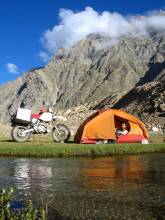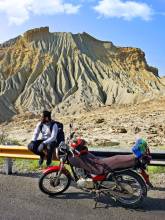Mountaineers' Guide: Ship Your Gear Safely to the Himalayas
Mountaineering in the Himalayas is an exciting adventure. However, transporting gear to this rugged terrain presents unique challenges. This is especially true for trips to Pakistan , which is home to some of the world’s highest peaks. Efficient cargo solutions are essential for safely moving your equipment. In this blog, we'll explore how to transport mountaineering gear securely. Over the years, cargo to Pakistan for mountaineering has grown significantly. Adventurers from around the globe have flocked to the country for a chance to summit its famous peaks, like K2 and Nanga Parbat. Transporting essential equipment for such expeditions has become a crucial part of the journey.
, which is home to some of the world’s highest peaks. Efficient cargo solutions are essential for safely moving your equipment. In this blog, we'll explore how to transport mountaineering gear securely. Over the years, cargo to Pakistan for mountaineering has grown significantly. Adventurers from around the globe have flocked to the country for a chance to summit its famous peaks, like K2 and Nanga Parbat. Transporting essential equipment for such expeditions has become a crucial part of the journey.
Why Transport Mountaineering Gear to the Himalayas?
Transporting your mountaineering gear to the Himalayas ensures you're fully prepared for the challenges ahead. High-altitude trekking requires specialised equipment like ropes, harnesses, tents, and oxygen supplies. Bringing your gear rather than renting locally ensures familiarity, quality, and reliability. Without reliable transportation of these essentials, your expedition could face delays or even cancellations.
The Challenges of Transporting Gear to High Altitude Regions
In high-altitude regions such as the Himalayas, transporting mountaineering gear is very difficult. First, the weight and size of the equipment present logistics issues. Cargo transport routes to remote regions are not always easy to chart. For example, roads in northern Pakistan run over rough terrain with unpredictable weather.
Other than these, there are also the complications of import and export regulations. Some gears have to be specially documented or obtain special permits to enter Pakistan. Knowing these requirements will help avoid some time delays. Planning is essential to the success of a hassle-free expedition.
Reputable Trekking Companies
Some companies offer professional trekking, and cargo solutions in mountaineering gear. These companies will give you an all-inclusive package: they will simplify the process of transporting your gear by dealing with the whole thing, from packing to delivering your gear directly to the base camp. They can save you so much time and effort.
Another benefit is the experienced workforce. These companies hire people who already know their way around and what it takes to get the job done. They have already carved out paths and have connections with local transport services for delivery to even the most remote locations.
General insurance options also form part of the packages. Since the price of mountaineering equipment is too expensive, insurance on all your equipment is required. Professional trekking companies offer you insurance policies that will cover your gear if lost, damaged, or delayed. For such an arduous expedition, this peace of mind will surely get you off to a great start.
Selecting the Best Cargo Solution
When shipping out to Pakistan, your mountaineering gear, the right cargo solution makes all the difference. It depends upon what is available within your budget, time, and volume of gear to be shipped. Each type of transportation has pros and cons. Here's a comparison of the most popular cargo solutions:
Air Cargo
Air cargo happens to be one of the quickest ways to send gear to Pakistan. It is a good way of reaching places quickly because air cargo stands as the best option for time-oriented adventurers. Airlines also have special services for oversized or heavy equipment, like mountaineering gear. Still, air cargo turns out to be pretty expensive, especially for large loads.
Flights to most areas of the Pakistan mountains will be very limited, so organize ground transportation from Islamabad.
Sea Cargo
Sea cargo is cheaper to ship large volumes of gear. It is an option if you have a couple of months of prep time for your expedition. Sea cargo is also very slow sometimes taking weeks to reach Pakistan. Not so great for expeditions where time is sensitive, sea cargo really works well if there is an organized group shipping bulk gear ahead of time.
However, when it is the case of seaport cities like Karachi, sea cargo options are very viable for large shipments. From there you will need to arrange for inland transportation.
Ground Transportation
Once your gear reaches Pakistan, ground transport becomes crucial. For transportation to high-altitude areas, local transport companies can carry your equipment. Trucking companies and local trekking agencies have specific trucks designed for difficult terrains. It may be time-consuming, but such transportation can be cheaper than aerial transport.
However, the roads in the mountainous regions of Pakistan are fragile. Use only reliable companies that have experience with routes of this kind. Most of all, adds potential delays due to landslides and weather.
Final Few Tips for Mountaineering This Expedition
Planning comes first in a successful mountaineering expedition. Firstly, there always needs to be an exhaustive inventory of your gear so as not to leave anything behind or lose it during transport; everything has to be clearly labelled for customs and transportation purposes.
Make sure to get cargo insurance. Regardless of whether you ship by air, sea, or land, accidents and delays can happen. Good insurance will help salvage your gear against damage or theft.
Lastly, keep in close communication with your cargo company. Ensure you get an idea of how long it's going to take for the delivery, and other possible obstacles along the way. Such a proactive attitude helps one avoid last-minute surprises that are likely to disrupt an expedition.
In conclusion, proper cargo planning is necessary for having a safe mountaineering adventure in Pakistan. With the right cargo solution, you can ensure that all your equipment comes to you in an unscathed condition so that you can have that time to focus on climbing ahead.







